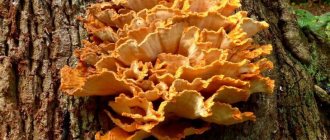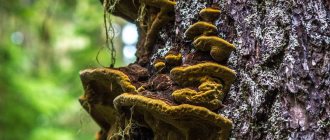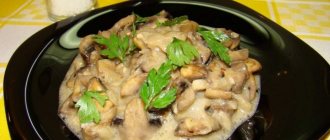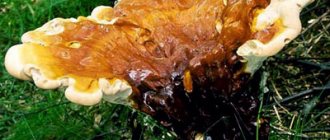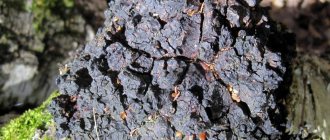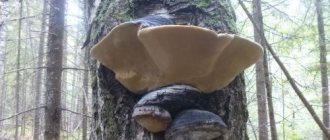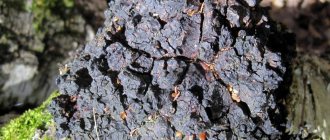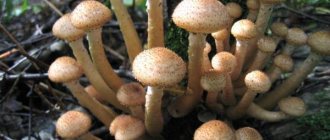When we say the word “mushroom”, we usually imagine a sunny forest and mushroom pickers with baskets... Or cooked milk mushrooms on our plate... Beauty! But there are other mushrooms - monster mushrooms, parasitic mushrooms. They, like real predators, attack our trees and destroy them. These are very dangerous and insidious creatures that are slowly and quietly destroying our gardens. What to do if you find mushrooms on trees? Why they grew, what they are like and how to prevent their appearance, we will tell you in the article.
Parasitic fungi on trees - prevention and control measures
What mushrooms grow on fruit trees
Only a few species of tinder fungus live on fruit trees. Each of them has their own preferences.
tinder fungus most often settles on the trunks of stone fruit trees, as well as pear trees . It can be identified by its yellow-brown or black-gray color and hoof shape. At an early stage of infection, this fungus can be detected by black stripes on the tree trunk. It, like most of its brothers, corrodes the wood from the inside and appears on the bark only in the 2-3rd year, when the inside of the trunk is already corroded by white core rot.
The false tinder fungus can destroy up to 80-100% of the trees on the site
Plum (or red) tinder fungus , despite its name, also affects all stone fruits, bird cherry, hawthorn, and sometimes apple and pear trees. It looks like a grayish-red trough with a blunt red edge, and in the first year its surface is velvety, and then hardens and becomes smooth. The wood of plants affected by this fungus turns yellow and becomes striped. First, the tree’s branches dry out and break for no reason, then the root system dies.
Infestation with plum polypore remains local for a long time, and can be gotten rid of by removing the diseased branch
The flat tinder fungus most often grows on stumps, but can also affect old pear or apple trees. Its grayish-white flat bodies appear at the base of the trunk and gradually rise upward. An infected tree suffers from white rot, drying out and brittleness.
Flat polypore is used in traditional Chinese medicine and also as a design element
The fastest “wood killer” is considered to be the sulfur-yellow tinder fungus , which settles on cherries and cherries. In just a year, it fills the exfoliating wood with its white films and comes to the surface. A tree on which you find fleshy, light yellow mushrooms with a wavy surface will die from brown heart rot.
At a young age, the sulfur-yellow tinder fungus is suitable for consumption after heat treatment
True tinder fungus , from which not a single deciduous tree is protected, grows for a very long time, corroding trunks and branches from the inside for years. Due to white rot of the core, the tree becomes brittle, splits along the annual rings and dries out. On the surface, the mushroom's body looks like pale gray hooves with yellow edges.
True tinder was historically used to make tinder, and is now occasionally used by beekeepers as fuel for smokers.
But the scaly tinder fungus is only dangerous for pears. Its light yellow or ocher annual bodies attach to the bark with a short stalk and cause white rot of the wood. Like the sulfur yellow one, this tinder fungus is capable of maturing and reproducing very quickly.
Young specimens of the scaly polypore are edible after heat treatment
“Taste preferences” of parasitic mushrooms
Xylotrophic fungi
differ not only in the speed of their destructive activity and external signs, but also in their taste preferences.
Some prefer already dead wood (dead wood, fallen wood, stumps, etc.), settling on living trees very rarely - true polypore , flat polypore , birch sponge , oyster mushroom , or oyster mushroom, common slit leaf , common scale . Others, on the contrary, primarily attack living trees. Some wood-decaying fungi are omnivorous and are capable of parasitizing on a variety of tree species - false polypore , sulfur-yellow polypore , scaly polypore , mowed polypore , or chaga , fatty scale . The other part of the mushrooms are real gourmets and prefer only one tree species - pine sponge , spruce sponge , larch sponge , butt spruce , aspen polypore , oak polypore , false oak polypore .
Some types of xylotrophs already settle on mechanically processed wood (logs, posts, boards) - sleeper mushroom, fence or pillar mushroom, multicolored tinder fungus, true house mushroom, filmy house mushroom.
Why do mushrooms grow on trees?
Polypores and other tree fungi are spread by spores that can be carried into the garden by birds, insects, or simply the wind. The likelihood of infection is especially high in areas where there is an old forest nearby that has not been cleared, or where there is deforestation.
Despite the fact that it is impossible to protect the garden from spores, it is important to understand that the tree will not simply become infected. In order for spores to penetrate the wood and begin to develop in it, two things are necessary: an open wound on the bark and a weakened state of the plant itself.
Polypore spores ripen in August, so try to ensure that there are no injured or weakened trees left in your garden by the end of summer.
Wounds on trees remain from frost holes, cracks, untreated saw cuts, holes from driven nails or screws, etc. Weakening of a tree occurs as a result of disease, improper care, or invasion of pests. Most often, old trees suffer from tinder fungi, since the wounds on them take longer to heal, and the tree’s immunity is not able to cope with the danger itself.
Causes of tree damage
The bark of a tree is a kind of skin that protects the tree from infection and insects entering its trunk. Damage to the bark is an open door for infection and tinder spores, among others. A plant can receive such damage for a number of reasons:
- weather impact,
- branches broken by the wind,
- sunburn,
- cracking from extreme cold.
Natural biological processes, in turn, can weaken trees. Dead branches or holes in the bark made by birds, insects or animals can easily open up infection. Humans also cause significant damage to the flora. Throwing knives and axes at trees leaves deep, long-lasting wounds on trunks and branches. Trees that are weakened and damaged by drought and old age are also targets for the tinder fungus.
Damaged tree bark is the main cause of infection
Why is tinder fungus dangerous on trees?
Inexperienced gardeners believe that the only drawback of tinder fungi is their unsightly appearance. In fact, everything is much sadder - such a “guest” in a couple of years can destroy a tree more surely than any disease.
The fact is that the outer part of the tinder fungus does not immediately appear on the trunk. The first few years after infection, the fungus grows inside the plant, feeding on its juices, and in return poisoning the wood with the fruits of its vital activity. Most often, after the tinder fungus, rot settles in the tree, which the weakened plant cannot fight.
Until the body of the fungus appears on the surface, the tree can still be saved if you determine in time what happened to it. As a rule, the color of the bark of infected fruit trees changes, black stripes appear on it, the branches begin to dry out and become brittle. Hollows may appear on the trunk, and the wood itself at the cut site looks flaking, with a rotting core. If you notice something like this while processing or pruning the garden, immediately begin resuscitation measures.
How to deal with parasitic fungi?
The presence of rot in a tree trunk can be indicated by certain signs known to experts (dry sides, swelling in the lower part of the trunk, mushroom fruiting bodies, decreased linear growth, etc.). But sometimes these signs are there, but there is no rot. It also happens the other way around - there is rot in the trunk, but it does not appear outwardly. And it’s even more unclear how to assess the size and extent of hidden rot?
It would seem that you can find out about this either by sawing the tree into pieces (which is radical), or by inviting a clairvoyant (which is doubtful). An error in both cases is fraught - either the abandoned tree will fall, or a non-dangerous specimen will be removed. However, there are devices that allow you to “look” inside a tree without causing virtually any harm to it.
resistograph device drills into wood with a thin drill, and sensors record its density (resistance to drilling). Using a computer program, a picture of the internal state of the tree is revealed. There is another device - an arbot.
This is a tomograph, the operating principle of which is based on measuring the speed of sound pulses passing through wood. The decision to remove or leave a tree standing is made not only on the basis of the data obtained as a result of instrumental diagnostics, but also taking into account the biological characteristics of the species, the inclination of the trunk, the architectonics of the crown, the characteristics of the site, the nature of nearby objects and other factors.
Depending on the degree of development of the rot, treatment or removal of the tree is possible if it is considered unsafe.
Treatment of hollows, as a rule, comes down to removing wood affected by mycelium, treating the inner surface with a fungicide, installing reinforcement, covering the surface with an insulating layer, sealing and masking the seal. It is advisable to entrust this work to specialists.
Preventing the appearance of fungi on trees
Those who want to protect their garden from parasitic fungi will not have to perform any feats and introduce any innovations in tree care. A strong, healthy tree with intact bark, sufficient watering and nutrition can itself resist tinder spores.
If you doubt whether you are doing everything correctly, let us recall a short list of necessary procedures:
- whiten trees in the fall to protect them from winter sunburn and frost damage;
- Carry out sanitary and formative pruning annually, and treat the cut areas with a 3% solution of copper sulfate and cover them with garden varnish;
- apply not only organic, but also complex mineral fertilizers to the trees at least twice a year;
- uproot old stumps, dead trees and bushes in the garden;
- do not let the trees dry out or become soaked;
- in early spring or late autumn (after leaf fall), spray the trees with a 5% solution of ferrous sulfate;
- promptly repair cracks or hollows that appear in the bark.
Root rot
In addition to stem rots, there are also root and butt-root rots. They are also caused by xylotrophic fungi, but they spread not only by spores, but also by contact between affected and healthy roots. Due to the distribution characteristics, the development of root rot in plantations usually has a clump character.
In coniferous trees, root rot is usually caused by a root sponge; it attacks deciduous trees much less often. Autumn honey fungus, or true honey fungus, is a typical polyphagous - it affects about 250 species of both coniferous and deciduous trees and shrubs (including fruit crops), causing sapwood butt-root rot. This fungus is capable of both parasitic existence and saprophytic feeding on dead wood (dead wood, fallen wood, but most often on stumps, which is reflected in the Russian name).
The oak, flat and Schweinitz polypores also lead to butt-root rot of trees.
How to get rid of polypores in the garden
If prevention does not help, and a fungal growth appears on one of your trees, proceed with treatment. During the first 2-3 years you still have a chance, but if the tree has already become fragile, covered with growths and hollows, then it is better to plant a replacement and prepare to uproot the affected plant.
It is important to treat a tree for parasitic fungi no later than August, so that the spores do not have time to spread throughout the garden. This is done like this:
- Use a sharp knife to cut the body of the mushroom from the tree;
- clean the cut area with a wire brush;
- if the mushroom is located on a branch, cut it to the base and examine the cut - light and clean wood indicates that this measure is sufficient, dark and rotten wood indicates the need to cut down the entire tree;
- treat the cut area with a 3% solution of copper sulfate, and then with garden pitch or an analogue;
- burn the body of the mushroom immediately, without throwing it away or composting it, since the spores continue to ripen in it even after separation from the tree;
- fill the hollows formed in the tree with a mixture of small crushed stone or gravel with cement or casein glue;
- Spray infected trees with a 1% solution of copper sulfate twice a year.
Remember that strong, healthy trees that are regularly and properly cared for will not become infected with parasitic fungi. Protect your garden and this problem will never affect you.
- 15 steps to a healthy garden - simple rules that will help preserve the harvest
Bacteria, viruses, fungi, pests strive to leave us without a harvest of fruits and berries. How to prevent disaster and protect your garden?
Parasites in the human body
Fungal spores settle not only on trees, shrubs and cereal crops. There are examples where they parasitize the body of animals and humans. Thus, cordyceps, which belongs to the class of higher fungi, affects the body of caterpillars. It develops inside the insect larva, sucking nutrients from it. This leads to the death of the host, and the cordyceps itself continues to grow through the body of the caterpillar for some time. As a result of this type of symbiosis, the caterpillar turns into a mummy. But the parasite is harmful and is widely used in folk medicine.
There are parasitic microorganisms in humans too. They come from the external environment and disrupt the functioning of the gastrointestinal tract, which is why it is important to monitor nutrition and not eat foods that have not been heat-treated. As for fruits, they should be washed thoroughly.
Some fungi live unnoticed in humans, while others manifest themselves immediately after appearing in the body. They most often settle on mucous membranes. As for the symptoms, the parasitic microorganism causes diseases that are associated with peeling of the skin. A striking example is psoriasis, which is practically untreatable. Lower fungi include mold, which causes serious diseases associated with the respiratory system. There are parasitic microorganisms not only in humans, but also in the body of animals. It's difficult to get rid of them.
Helps destroy parasitic organisms that cause allergies and eating disorders, propolis tincture, onions and garlic. Pharmacies sell special antifungal drugs. They contain active components that destroy fungal spores.
